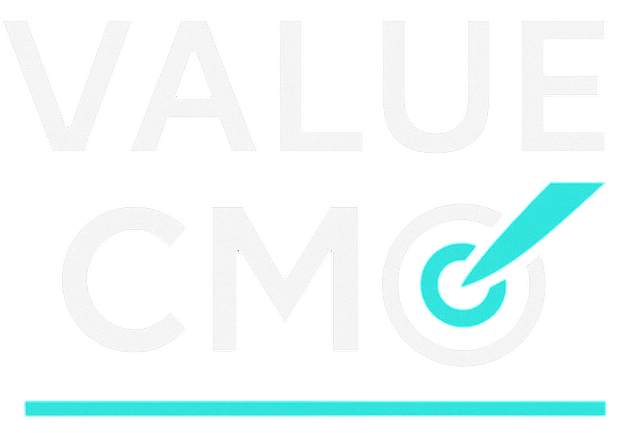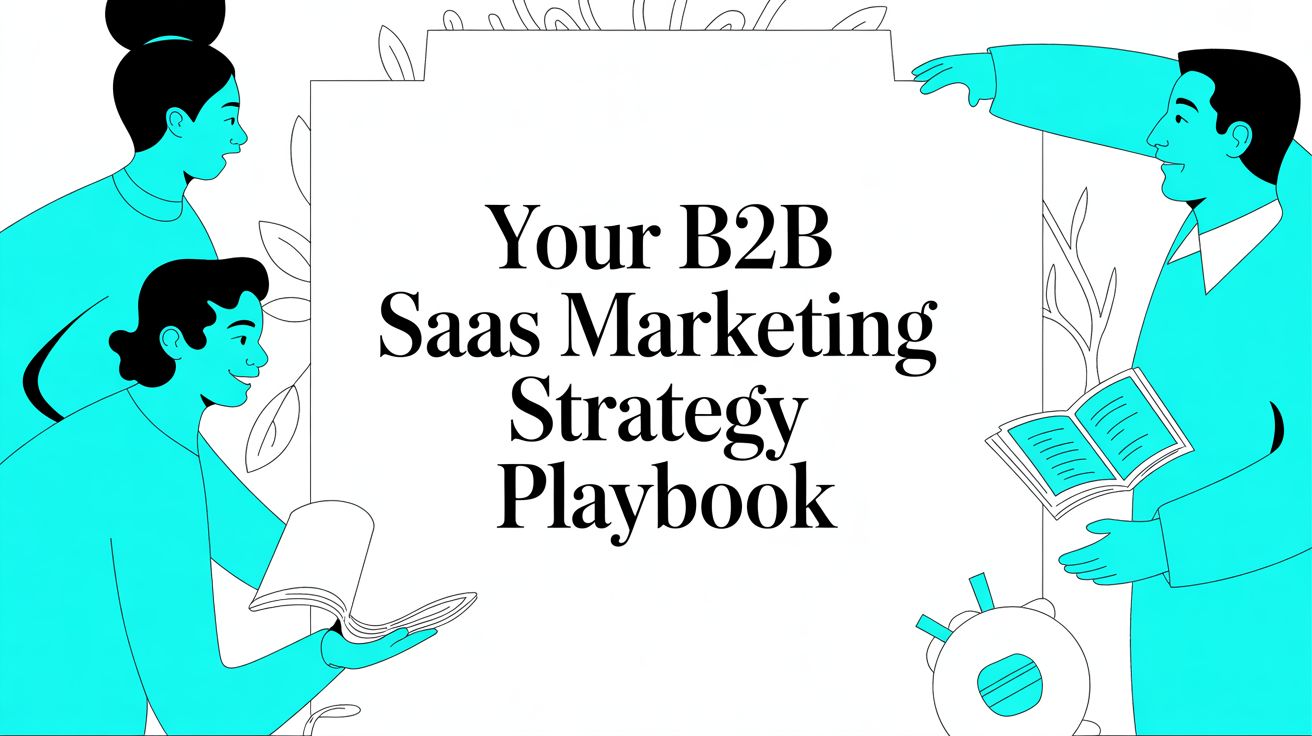A solid B2B SaaS marketing strategy isn't about chasing the latest shiny object. It’s about building a focused, sustainable growth engine. It goes way beyond just running a few ads and hoping for the best; it's about deeply understanding your customer, picking your channels wisely, and never stop measuring. Get this right, and you build a real, defensible edge over everyone else.
Rethinking Your B2B SaaS Marketing Strategy
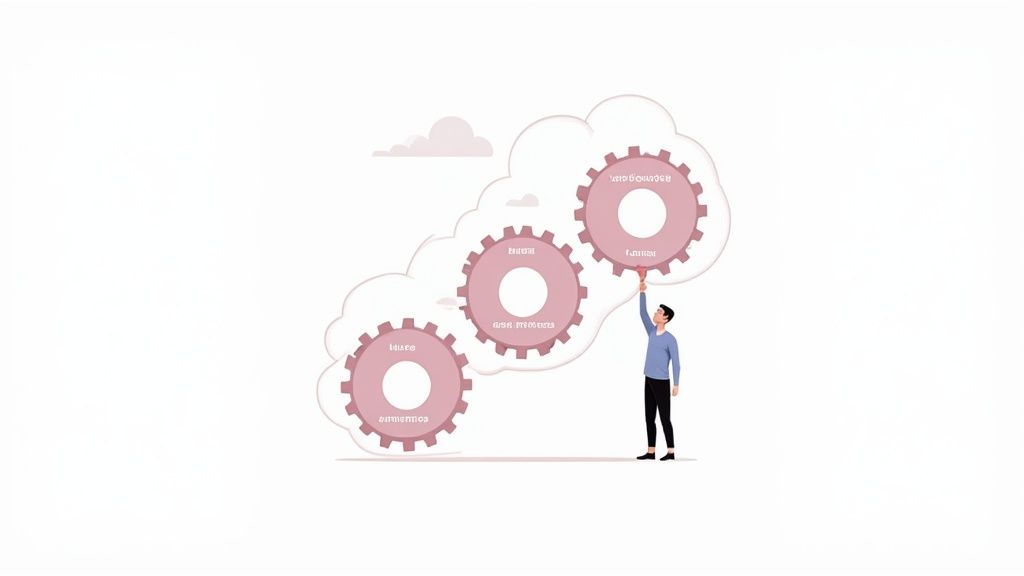
First things first: let's forget the one-size-fits-all playbook. What works for a B2C app or even another SaaS company in a different niche won't necessarily move the needle for you. The B2B SaaS world is its own unique beast. We're talking longer sales cycles, buying committees with multiple decision-makers, and a critical need to build deep, lasting trust.
A modern strategy accepts these realities. So many companies fall into the trap of just "doing marketing"—running ads, posting on social, publishing blog posts—all without a cohesive plan. That scattergun approach just burns cash and leaves your pipeline flat.
A truly effective strategy is less about the volume of activity and more about the quality and focus of your efforts. It’s a deliberate framework designed to attract, engage, and convert your ideal customers, period.
The Core Pillars of a Modern Approach
At its heart, a winning strategy is built on a few non-negotiable pillars. These parts all work together to create a powerful engine for growth, making sure every marketing dollar is an investment, not an expense.
A solid plan always includes:
- A Crystal-Clear Ideal Customer Profile (ICP): You have to know exactly who you're talking to. What’s their role? What are their biggest headaches? What gets them to buy? This isn't optional.
- Defined, Measurable Goals: Ditch the vanity metrics. Let's focus on what actually drives revenue—things like lead quality, pipeline velocity, and customer acquisition cost (CAC).
- Smart Channel Selection: Don't try to be everywhere. Pick the battlegrounds where your ICP actually spends their time and go deep there.
- A Commitment to Iteration: Treat marketing like a science. You need to be constantly testing, learning, and tweaking based on real performance data.
A great strategy isn't some static document you create once and forget about. It's a living roadmap. It provides direction but stays flexible enough to adapt to market feedback and changing customer needs. This agility is what separates the market leaders from everyone else.
Understanding the Financial Framework
Budgeting is the other critical piece of this puzzle. You have to ground your strategy in financial reality.
Historical benchmarks show that combined sales and marketing budgets often land between 30% to 50% of total revenue. Venture-backed SaaS companies tend to push this higher, allocating around 47% of their revenue to growth, which is a big jump from the 33% you see in private equity-backed firms.
Knowing these numbers helps anchor your strategy in what's possible and sustainable for your company's stage. You can dive deeper into 2025 B2B SaaS marketing benchmarks to see how these figures vary. This data-informed perspective ensures your goals are ambitious but not delusional.
Pinpointing Your Ideal Customer Profile
Before you write a single line of copy or drop a dollar on ads, you have to nail the most important question in B2B SaaS: who are you actually selling to?
It sounds basic, but this is where countless marketing plans fall apart. They try to talk to everyone, and in doing so, they end up connecting with no one.
The goal isn't just to define a market; it's to build a detailed, almost personal understanding of your Ideal Customer Profile (ICP). This goes way beyond basic firmographics like company size or industry. A truly powerful ICP feels like a real person with real problems you can solve.
Moving Beyond Surface-Level Data
Too many teams stop at the basics: "We sell to mid-market tech companies in North America." That’s a start, but it’s way too broad to be actionable. An effective ICP gets into the nitty-gritty details that actually drive buying decisions.
You need to become a detective, piecing together clues from across your business. Don't just rely on assumptions from the marketing department. Your best insights are usually hiding in plain sight.
Here’s where to look:
- Customer Interviews: Seriously, get on the phone with your best, most successful customers. Ask them about their world before your software. What specific pain point got so bad it sent them searching for a solution? What was the final straw?
- Sales Team Feedback: Your sales reps are on the front lines every single day. They hear all the objections, the questions, and the "aha" moments that turn a prospect into a customer. They know which types of companies close faster and stick around longer.
- Product Usage Data: Dig into how your top customers use your product. Which features do they live in? High engagement in specific areas is a huge clue about the core value they get, which tells you a lot about their primary motivations.
Building Your ICP Framework
Once you've gathered all this intel, it's time to pull it together into a clear, documented profile. This isn't just a thought exercise; it's a strategic asset that will steer every marketing decision you make from here on out.
Try organizing your findings around these key areas:
- Company Characteristics: Industry, size (both revenue and employee count), geography, and even their current tech stack. Are they a fast-growing startup or an established enterprise?
- Key Persona Details: The specific job title of your champion or the ultimate decision-maker. What are their daily frustrations? What metrics are they on the hook for?
- Pain Points and Triggers: What’s the specific, nagging problem your software eliminates? What event usually kicks off their search for a fix—a failed audit, a missed revenue target, a manual process that finally broke?
- Watering Holes: Where do they hang out online to get information? Are there specific podcasts, industry blogs, or LinkedIn groups they trust?
A well-defined ICP is your marketing north star. When you're debating ad copy, a blog topic, or a new feature, you can always ask, "What would 'Marketing Manager Melanie' at a 200-person tech company think of this?" This simple gut-check keeps your entire strategy focused and relevant.
Understanding your ICP also sets you up for more advanced tactics. Knowing their pain points and where they search for answers is the foundation for an effective strategy around intent-based marketing for B2B tech startups. It allows you to target prospects who are actively looking for what you offer.
When you combine deep customer knowledge with the right buying signals, your marketing becomes less about shouting into the void and more about showing up at the perfect moment with the perfect answer.
Choosing Your Marketing Battlegrounds
You can’t be everywhere at once, and honestly, you shouldn’t even try. The secret to a killer b2b saas marketing strategy isn't about planting a flag on every platform; it's about making smart, data-informed bets on where to invest your time and budget.
This is all about choosing your battles wisely. Go deep on the channels where your ICP actually lives.
Spreading your resources too thin is a surefire recipe for mediocre results across the board. The real goal is to build a cohesive, multi-channel approach where each channel plays a specific role, working together to guide prospects from "who are you?" to "take my money." Think of it less like a checklist and more like building a strategic portfolio of marketing investments.
To do this right, you need to map potential channels directly back to the Ideal Customer Profile you’ve built. Where do they go for information? What communities do they trust? Answering these questions is the first step toward building a plan that delivers real, compounding returns.
The Organic vs. Paid Growth Levers
Every channel discussion in B2B SaaS eventually boils down to a fundamental choice between long-term and short-term growth levers. You need a healthy mix of both to win.
Content and SEO are your long-term, organic growth engine. It’s an investment that builds on itself over time. Creating valuable blog posts, guides, and tools that answer your ICP's core questions establishes your authority and creates a durable asset that can attract qualified traffic for years. It's not fast, but the payoff is a sustainable, low-cost source of leads.
On the other hand, paid channels like LinkedIn and Google Ads are your short-term acquisition tools. They offer precision targeting and immediate feedback. Need to test a new message or drive traffic to a webinar now? Paid is your go-to. It's faster but requires a constant budget and sharp optimization to stay profitable.
The most successful strategies don't see this as an "either/or" choice. They use paid channels to capture immediate demand and gather data, while simultaneously investing in SEO and content to build a long-term competitive moat that becomes cheaper over time.
Prioritizing High-Impact B2B SaaS Channels
While the digital world offers endless options, a few channels consistently prove their worth in B2B SaaS. The key is to understand their unique strengths and how they align with your business goals.
For instance, email marketing remains the primary channel, used by 66% of B2B SaaS marketers globally. It's followed closely by paid social media at 58% and paid search at 50%.
But some channels punch well above their weight. Webinars, for example, generate up to 73% higher-quality leads compared to other marketing channels. You can learn more about these B2B SaaS marketing trends on martal.ca.
To help you decide, here's a breakdown of the top contenders:
- SEO and Content Marketing: This is the foundation for attracting problem-aware prospects. It's perfect for top-of-funnel education and building trust before a prospect even knows they need a tool like yours. It’s all about creating demand, which is a crucial first step. You can explore more on the difference between demand generation vs lead generation in our guide.
- LinkedIn Ads: No other platform offers the same level of professional targeting. It's ideal for reaching specific job titles, industries, and company sizes, making it a powerhouse for Account-Based Marketing (ABM) and promoting mid-funnel content like case studies or whitepapers.
- Google Ads (Search): This channel is unbeatable for capturing high-intent prospects who are actively searching for a solution. Targeting keywords like "[your competitor] alternatives" or "[your software category] tool" puts you directly in front of buyers at the exact moment they're ready to make a decision.
- Webinars and Virtual Events: These are fantastic for building relationships at scale. They allow you to demonstrate expertise, answer questions in real-time, and generate highly qualified leads who have already invested an hour of their time with your brand.
The infographic below shows how different data sources—like customer interviews and product usage data—inform which channels and messaging will actually resonate.
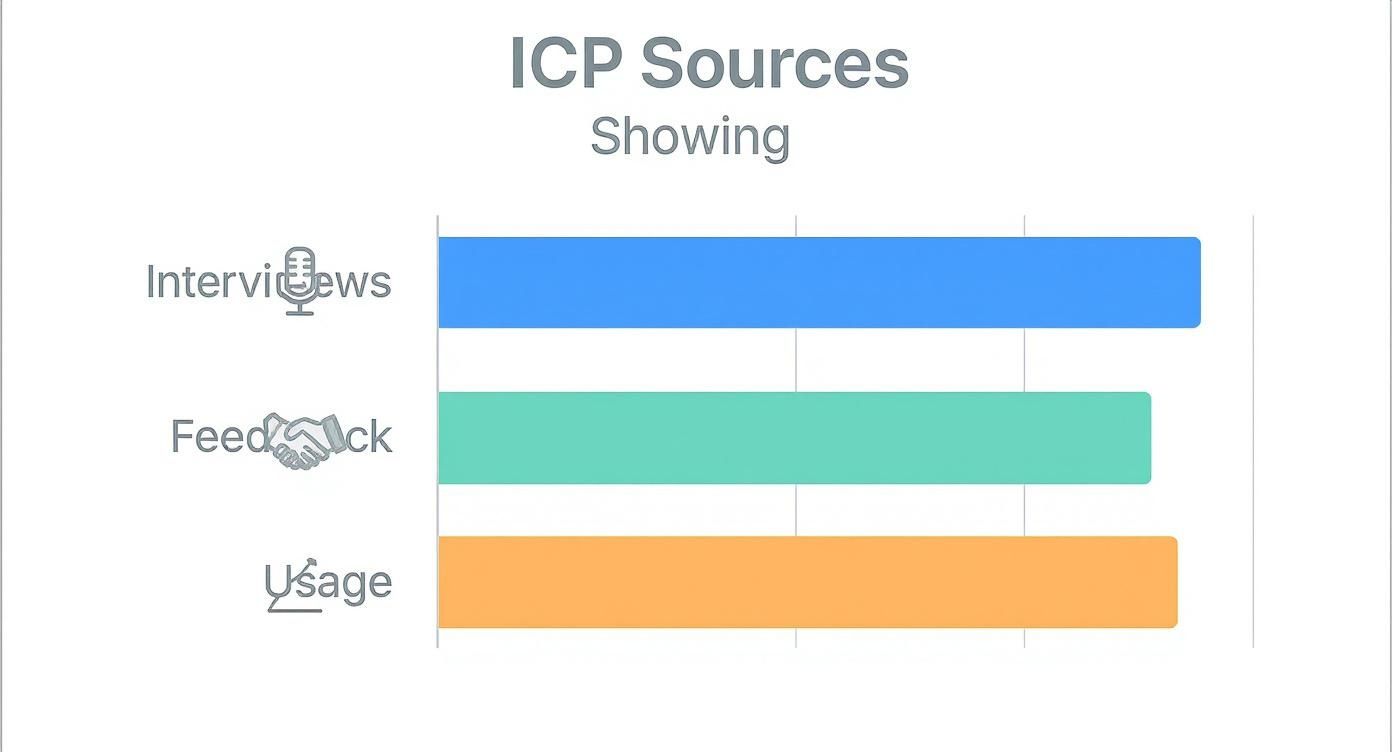
This data directly influences channel selection by revealing where your best customers discover solutions and what language they use to describe their problems.
Comparing Top B2B SaaS Marketing Channels
Choosing the right channel mix depends heavily on your goals, budget, and stage of growth. This table breaks down the heavy hitters to help you make a more informed decision.
| Channel | Primary Use Case | Key Metrics | Best For |
|---|---|---|---|
| SEO & Content | Building long-term authority and attracting top-of-funnel traffic. | Organic Traffic, Keyword Rankings, MQLs | Early-stage and growth companies building a sustainable lead engine. |
| LinkedIn Ads | Precise targeting for ABM and promoting mid-funnel content. | Cost Per Lead (CPL), Click-Through Rate (CTR), Demo Requests | Companies with a well-defined ICP targeting specific roles/industries. |
| Google Ads | Capturing high-intent searchers at the bottom of the funnel. | Cost Per Acquisition (CPA), Conversion Rate, ROAS | Companies with a clear value prop looking for immediate, qualified leads. |
| Webinars | Lead generation, product demos, and building thought leadership. | Attendee Rate, MQLs from attendees, Pipeline Influence | Growth-stage companies looking to educate the market and nurture leads at scale. |
Ultimately, the best strategies combine these channels. You might use SEO to attract an audience, LinkedIn to retarget them with a webinar invite, and Google Ads to catch them when they search for your competitors.
Analyzing the Competitive Landscape
Finally, don't build your channel strategy in a vacuum. A quick analysis of what your competitors are doing can reveal huge opportunities.
Use tools like Ahrefs or Semrush to see what keywords they rank for and what topics drive their organic traffic. Check their ad libraries on LinkedIn and Google to understand their messaging and targeting.
You're not looking to copy them, but to identify gaps. Are they neglecting a specific persona? Is there an underserved content niche you can dominate? Finding these open lanes is how you can outmaneuver bigger players without needing a bigger budget.
Creating Content That Actually Connects
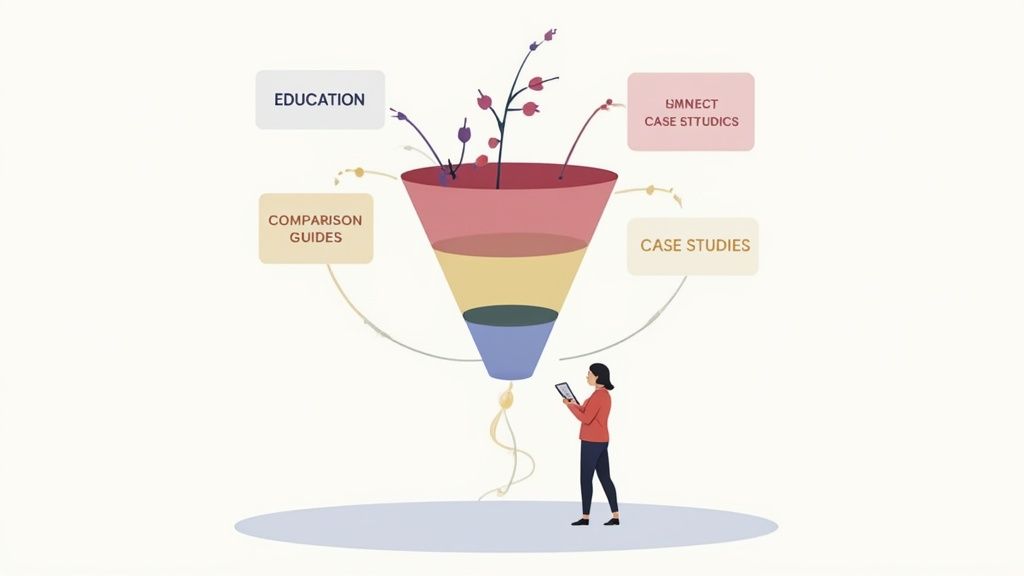
In B2B SaaS, your content isn’t just marketing fluff—it’s a core part of your product experience. Prospects don't want a sales pitch. They want to be educated, understood, and guided. Your content is the first and best way to build that trust, long before they ever agree to a demo.
A killer b2b saas marketing strategy is about more than just churning out blog posts. It's about building a deliberate, full-funnel content machine where every single piece has a job—guiding your Ideal Customer Profile (ICP) from "who are you?" to "take my money."
When you get this right, you stop being just another vendor. You become the go-to authority in your space.
Mapping Content to the Buyer’s Journey
To build a content engine that drives real growth, you have to think like your customer. Their journey is messy, not a straight line, so your content strategy needs to meet them wherever they are. Let's break down the stages and what to create for each.
First up is the top of the funnel (TOFU). At this point, your prospects are problem-aware, not solution-aware. They aren’t Googling your brand; they’re Googling their frustrations.
Your only goal here is to be helpful, not salesy. Think about creating:
- Educational blog posts that hit on common pain points or industry shifts.
- In-depth guides and eBooks that offer a comprehensive take on a broad problem.
- Original research or data reports that establish you as a thought leader.
This is how you capture organic traffic from people who fit your ICP but have no idea you exist yet.
Building Credibility in the Middle
Once a prospect knows your name, they slide into the middle of the funnel (MOFU). This is the evaluation stage. They’re sizing you up, comparing options, and trying to decide if you’re the real deal. Your content's job is to build unshakable credibility.
Here, you shift from broad education to specific proof. Show, don't just tell.
- Case Studies: Nothing beats a story from a customer who looks just like them and won with your help. Your customer's success is your best marketing.
- Webinars: Live or on-demand sessions let you flex your expertise, showcase the product in a low-pressure setting, and answer direct questions.
- White Papers: These deep dives into a specific methodology or challenge prove you have the chops to solve their most complex problems.
Your middle-of-funnel content is your trust-building machine. It answers the one question on every prospect's mind: "Why should I believe you?" By showing real results, you give them the confidence to move forward.
Sealing the Deal at the Bottom
Finally, we hit the bottom of the funnel (BOFU). Your prospects are ready to pull the trigger. They’re comparing you against two or three competitors and need content that vaporizes their final doubts and makes the choice obvious.
This content needs to be direct and action-oriented.
- Comparison Guides: Don't be shy. Create honest, detailed pages comparing your product to key competitors. This is your chance to own the narrative.
- Pricing Pages and ROI Calculators: Be transparent about cost and help them build the internal business case for your tool. Make it easy for them to say yes.
- Customer Testimonials and Reviews: Social proof is everything here. Splash quotes, videos, and reviews from happy customers everywhere.
This full-funnel approach ensures you have an answer ready for any question, at any stage. And the data agrees: about 91% of B2B marketers use content marketing to build authority. It's so critical that 46% of SaaS marketers are upping their content budgets to better educate customers. You can read more about these B2B SaaS growth strategies on hubifi.com.
To keep up, many teams are now using an AI-assisted writing workflow to scale content production without killing quality. By blending human expertise with smart tools, you can build a powerful content library that connects with your ICP at every single touchpoint.
Measuring What Matters for Growth
Marketing without measurement is just expensive guesswork. You can have the slickest campaigns on the planet, but if you don't know what’s actually working, you're just burning cash. A real B2B SaaS marketing strategy is built on hard data, not gut feelings.
The whole point is to get past vanity metrics. Clicks, impressions, and follower counts look nice on a slide, but they don’t pay the bills. Your focus needs to be on the core SaaS metrics that tie every marketing dollar directly to revenue and long-term business health. This is how you prove your value and make smarter bets.
Your Core SaaS Marketing Scorecard
To get a real pulse on your marketing performance, you only need to track a handful of key metrics. These numbers tell the true story of your growth, profitability, and customer health. This is the language your CEO and board speak, so you need to be fluent.
Here are the essentials for any B2B SaaS marketing dashboard:
- Customer Acquisition Cost (CAC): This is the total sales and marketing cost to land one new customer. Just divide your total spend over a period by the number of new customers you brought in. Simple, but powerful.
- Lifetime Value (LTV): This is a prediction of the total revenue one customer will bring in over their entire relationship with you. For a healthy business, your LTV needs to be way higher than your CAC.
- Churn Rate: The percentage of customers who cancel their subscriptions in a given period. High churn is a silent killer for SaaS companies, so you have to watch it like a hawk.
- LTV to CAC Ratio: This is the ultimate health check for your growth engine. The benchmark for a healthy SaaS business is a ratio of 3:1 or higher—meaning a customer is worth at least three times what it cost you to acquire them.
These metrics don't live in a vacuum. A low CAC is great, but not if you're acquiring low-LTV customers who churn out in two months. Tracking them together ensures you’re building sustainable, profitable growth, not just chasing empty stats.
Connecting the Dots with Attribution
Knowing your overall CAC is a solid start. But the real insight comes when you can break it down by channel. Which of your marketing efforts are actually delivering profitable customers? That’s where attribution modeling comes in.
An attribution model is just a rulebook for giving credit to the different touchpoints a customer interacts with on their way to buying. Without one, you’re probably giving too much credit to some channels and not enough to others.
There are a few models to know:
- First-Touch Attribution: Gives 100% of the credit to the very first interaction a lead had with you (like the first blog post they read). It's great for seeing what's driving initial awareness.
- Last-Touch Attribution: The opposite. It gives all the credit to the final touchpoint before a conversion (like the Google Ad they clicked right before signing up). It tells you what closes deals but misses the journey that got them there.
- Multi-Touch Attribution (e.g., Linear or U-Shaped): These models spread the credit across multiple touchpoints. A U-shaped model, for instance, might give 40% to the first touch, 40% to the last touch, and split the remaining 20% among the interactions in between. This gives you a much more balanced view.
Don't get paralyzed trying to find the "perfect" attribution model. The goal is progress, not perfection. Start with a simple model like first- or last-touch to get a baseline. You can always evolve to a more sophisticated multi-touch model as you get more comfortable with the data.
Building a Culture of Experimentation
Measurement isn’t just about reporting on what happened last month; it’s about making better decisions next month. This is where you need to build a culture of constant experimentation. Your marketing plan shouldn't be a static document—it should be a series of hypotheses you're constantly testing.
This is where A/B testing becomes your best friend. It’s a simple way to compare two versions of something—a landing page, an email subject line, ad copy—to see which one performs better.
Treat it like a science experiment:
- Form a Hypothesis: "I bet changing our CTA from 'Request a Demo' to 'See a Live Demo' will boost conversions because it sounds more immediate and valuable."
- Run the Test: Use a tool to show 50% of your visitors Version A and 50% Version B.
- Analyze the Results: Wait for a statistically significant sample size, then see which version won.
- Implement and Iterate: Roll out the winning version as the new control and move on to your next hypothesis.
By running these small, continuous tests, you can achieve huge, compounding gains over time. This data-driven approach removes ego from the equation and ensures every part of your marketing machine is always getting a little bit better.
Your B2B SaaS Marketing Questions Answered
Even with the best roadmap, hitting the ground running with a B2B SaaS marketing strategy raises a ton of questions. Let's tackle some of the most common ones that crop up once the planning is done and the real work begins.
Think of this as a quick-fire round to clear up those nagging doubts. We'll get into how long it really takes to see results from SEO and the classic debate: hire in-house or bring in outside experts? The goal here is to give you straight, actionable answers for the challenges you're about to face.
How Long Does It Realistically Take to See SEO Results?
This is the big one. The honest answer? It depends, but patience is non-negotiable. Unlike paid ads, which can start sending traffic your way instantly, SEO is a long game. For a brand-new website or one with very little authority, you're looking at 6 to 12 months before you start seeing meaningful, steady organic traffic from your efforts.
A few key factors will either speed that up or slow it down:
- Your Industry's Competitiveness: Trying to rank for "project management software"? That’s a long, uphill battle in a crowded space. Targeting niche, long-tail keywords in a newer market will get you on the board much faster.
- Your Content Velocity and Quality: The more high-quality, SEO-optimized content you publish, the quicker Google starts to see you as a voice of authority. One blog post a month just won't cut it. Aiming for 2-4 quality pieces per week can seriously accelerate your timeline.
- Your Technical SEO Health: Site speed, mobile-friendliness, and a clean site structure matter—a lot. A website that's technically sound gets indexed and ranked faster. Simple as that.
Don't get discouraged if you don't see a traffic spike in the first three months. The early wins are often ranking for less competitive, long-tail keywords. These build your authority over time, setting the stage for bigger wins down the road.
Should I Hire In-House or Use a Fractional Team?
This is the classic growth-stage dilemma. Do you take on the cost and ramp-up time of hiring a full-time marketing team, or do you bring in fractional experts or an agency to hit the ground running? There’s no single right answer, but here’s how to think it through.
Hiring in-house is fantastic for building deep product and customer knowledge. An internal team lives and breathes your company culture, which is invaluable for creating authentic content and campaigns. The downside? The cost, the lengthy hiring process, and the risk of a bad hire setting you back months.
Using a fractional team or agency gives you immediate access to specialized expertise without the full-time overhead. You can tap into a senior-level strategist, a paid ads pro, and an SEO expert on a flexible basis. This is perfect for startups needing top-tier guidance and execution without the budget for a full marketing department. The trick is to find a partner who truly embeds with your team, not just a vendor who sends over reports.
What’s More Important: Brand Building or Lead Generation?
Too many marketers treat this as an either/or choice. The truth is, the best B2B SaaS marketing strategies harmonize both. They aren't opposing forces; they're two sides of the same coin, and they amplify each other.
Lead generation is all about capturing existing demand. Think bottom-of-the-funnel tactics like running Google Ads for high-intent keywords or creating competitor comparison pages. It’s absolutely essential for hitting your short-term revenue targets and proving ROI.
Brand building, on the other hand, is about creating future demand. This is your top-of-funnel work—publishing genuinely helpful content, hosting webinars, and building a community. It doesn't always have a straight line to a sale today, but it’s what makes prospects choose you when they're finally ready to buy.
A balanced strategy does both. You use lead gen to capitalize on today’s opportunities while you build your brand to ensure a steady stream of warmer, more qualified leads tomorrow.
Ready to stop guessing and start executing a b2b saas marketing strategy that delivers real results? Value CMO provides the senior marketing leadership you need without the full-time overhead. We build focused, data-driven growth roadmaps to scale your pipeline and revenue. Let's build your growth engine together.
Article created using Outrank
